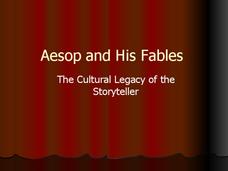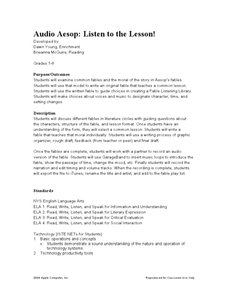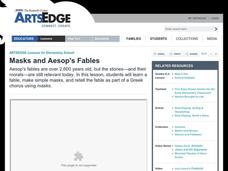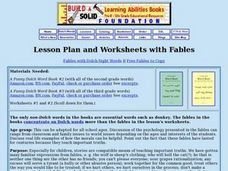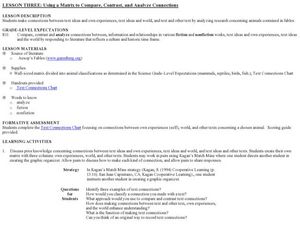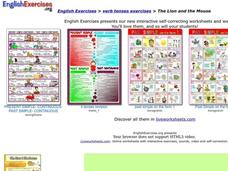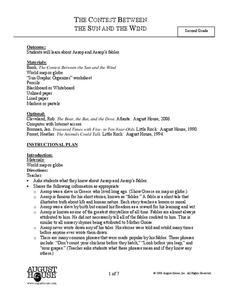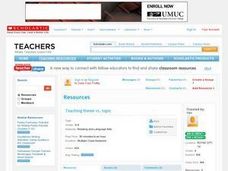Active 770
Aesop and His Fables
Most people have heard of Aesop's Fables, but who was Aesop and when did the fables actually get recorded? Teach your class all about Aesop and fables in general with the presentation before inviting them to examine several fables and...
Curated OER
Aesop's Fables
Examine the fables of Aesop with your class. Pupils identify the morals of fables and role-play a scene from their favorite fable of Aesop. Additionally, they compose letters to a favorite character in the fable. Learners role-play again...
Curated OER
What is a Philanthropist?
What does a philanthropist do? Help your class explore philanthropy using character development and literacy ideas. Learners will define and give examples of philanthropy, listen to The Lion and the Mouse, discuss how the characters help...
Curated OER
Drama: Learn A Lesson from the Lion
Reading is reading, whether it's for drama or English class. Boost reading fluency, accuracy, intonation, and comprehension while fostering creative acting skills. Kids read the provided tale of "The Lion and the Mouse" several times in...
Curated OER
Aesop's Fables
Regale your class with renditions of Aesop's fables from the engaging, and beautifully illustrated book by Jerry Pinkney. Guide discussion to practice prediction, compare and contrast various stories, explore the connections between the...
Curated OER
Deciding Theme
Read aloud to your class the fable "The Lion and the Mouse" as you explore characters' choices and the effects they have on a story. Apply what is discussed to finding a theme of the chapter "Not Giving Up" from The Wizard of...
Curated OER
Audio Aesop: Listen to the Lesson!
Aesop's Fables are the focus of this language arts lesson plan. Young philosophers study and discuss the morals found in the most famous of Aesop's Fables. They write an original fable that teaches a common moral. A "Fable Listening...
Curated OER
What is a Fable?
Students read a variety of electronic Aesop's fables to define fable and moral, and write and illustrate an original fable. They then publish their fable using PowerPoint.
Curated OER
Comprehension Skills: Evaluate Using Fiction Stories and Aesop's Fables
Primary readers investigate several comprehension skills in the ten lessons of this unit. Forming opinions about stories, comparing stories to each other, using Venn Diagrams, and applying the ideas from a story to real life situations...
NWT Literacy Council
Readers Theatre Scripts
Engage and entertain young learners with this collection of readers theatre activities. With over 25 different scripts, a wide range of topics are covered from simple counting and rhyming exercises to adaptions of popular children's...
Curated OER
Up-to-Date Aesop
Students translate one of Aesop's fables into a modern setting with modern language. They illustrate a fable using art supplies or illustration software on the computer.
Curated OER
Lots of Lessons from Aesop
Aesop’s Fables offer young learners an opportunity to study figurative language. After reviewing theme, simile, alliteration, and metaphor, model for your pupils how to identify examples of these devices in the fable. Class members then...
Curated OER
Aesop's Fables (Grade 3)
Third graders develop a presentation based on Aesop's Fables. For this Aesop Fables and presentation lesson, 3rd graders examine the characteristics of fables and how to interpret them. They choose one of Aesop's Fables to research. They...
Curated OER
Masks and Aesop's Fables
Students study and perform Aesop's fables. In this Aesop's fables lesson, students read and/or listen to a number of the famous fables. They make masks based on the characters and perform a fable using the masks. They write about the...
Curated OER
Counting Crows
Students discuss the fable, The Crow and the Pitcher. In this literature instructional activity, students read the fable and create a crow sock puppet. Students use their puppets to dramatize the fable.
Curated OER
Aesop's Fables: Unity
In this language arts and literature worksheet, students read 3 separate Aesop's fables that all have the theme of unity. Students then complete 5 pages of essay questions, short answer, detail checking, higher meaning reflections and...
Curated OER
Aesop's Fables: Fitting In
In this literature worksheet, students read one of Aesop's fables that has the theme of fitting in. Students then complete 7 pages of questions: detail checks, deeper meanings, imagination exercises, drawing characters and scenes, a...
Curated OER
Fables
Third graders identify the characteristics of fables, and read and compare/contrast various Aesop's fables. Using handheld computers, they read two fables with a partner, complete a Venn Diagram, develop a traits diagram using PiCo Map,...
Curated OER
Fables
Third graders discover characteristics of fables by reading Aesop's fables and performing a reader's theater.
Curated OER
Using a Matrix to Compare, Contrast, and Analyze Connections
Students explore writing techniques by comparing fiction vs. non-fiction. In this literature analysis lesson, students read stories from Aesop's Fables and compare the themes and characters to stories from their own life. Students...
Curated OER
Reading Exercises: "The Lion and the Mouse"
In this reading exercise online worksheet, students watch a YouTube video of the "The Lion and the Mouse." They use the drop down menu at the end of each of 9 sentences to tell if the sentence is from the story or not. They check their...
Curated OER
The Lion and the Mouse
In this language arts worksheet, students fill in the blanks to sentences, complete multiple choice questions, answer short answer questions, and more for the story The Lion and the Mouse. Students complete 5 exercises.
Curated OER
The Contest Between The Sun And The Wind
Second graders read fables by Aesop and learn about the famous storyteller. In this fables lesson plan, 2nd graders discuss questions about Aesop and then write their own fable.
Curated OER
Theme vs. Topic
Young scholars use Aesop's fables to examine theme and topic. In this theme and topic instructional activity, students read different fables and discussing as a class. After hearing more stories young scholars work in pairs to...


